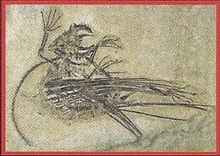Coelurosauravus had the Wright brothers beat by about 250 million years. This small reptile was the first advanced creature known to be able soar through the skies. It did this by extending ridged wings while jumping from a tree, and could glide for great distances. This ancient reptile lived almost entirely in trees, and chewed up any insects it found crawling on the bark.
Head Plate: This ancient reptile had a bony frill on top of its head, like a miniature triceratops without horns. The frill was spiked around the edges, and offered protection against an enemy's teeth.
Mmm, Crunchy: Coelurosauravus had beak-like jaws that were lined with small but pointy teeth. The creature hunted insects among prehistoric trees and easily crunched through their armor with these weapons.
First in Flight[]

Fossils show that bony rods supported this creature's wings.
The fossils show it all: Coelurosauravus was the first animal more advanced than an insect that could take to the air. Bony rods connected by thin layers of skin (like a fish's fin) grew from the reptile's sides. These "wings" were retractable; the reptile jumped from tree branches and unfolded them to catch the breeze and soar for hundreds of feet to a new tree. Unlike the similar "wings" of the modern flying lizard, coelurosauravus' weren't connected to its ribs, and worked separately from any other muscles in its body.
Flight Control: This creature's long tail made up half of its total body length. While in flight, coelurosauravus used it to control its glides, steering itself through the air by moving the tail to the right or the left.
Pre-Dino: Coelurosauravus lived 250 million years ago, about 20 million years before the first dinosaurs showed up. The creature was wiped out in a disaster that killed 90% of all life on Earth.
Next Stop...[]
- Early in the morning, several coelurosauravuses cling onto the trunk of a tree, at least a hundred feet above the ground. They spread their wings to help absorb heat so they can get their hunting started for the day.
- As they charge up with energy from the sun's heat, the reptiles leap and glide on the air. Some take a short flight to nearby trees, but others soar on the wind and land on trees much farther away, on which more tasty insects are crawling.
